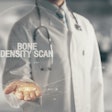Tomosynthesis with a digital radiography (DR) system may be more effective than conventional radiography in diagnosing knee osteoarthritis, according to research published in the April issue of Radiology.
In a study involving 40 patients and 80 knees, a Boston University School of Medicine team, led by senior author Dr. Ali Guermazi and lead author Dr. Daichi Hayashi, found that tomosynthesis detected more osteophytes and subchondral cysts than radiography (Radiology, April 2012, Vol. 263:4, pp. 206-215).
The researchers sought to assess the value of tomosynthesis for imaging the knee joint and to determine its accuracy in detecting osteoarthritis signs in the knee. All patients, who were recruited for the study irrespective of knee pain or a radiographic diagnosis of osteoarthritis, received radiography, tomosynthesis, and MR scans. The presence of osteophytes and subchondral cysts was recorded, and knee pain was assessed for each participant based on a questionnaire, according to the researchers.
In comparison with radiography, tomosynthesis increased sensitivity by 5% to 29% for detecting osteophytes and by 11% to 50% for detecting subchondral cysts in the knee joint. The researchers also found that subjects with tomosynthesis-detected osteophytes and cysts were more likely to feel pain than those without the lesions.
The study was funded via a grant from GE Healthcare.



















